Business
Why Amazon HQ2 Should Choose Austin
Published
7 years agoon
By
Ginny Nguyen
Amazon had made October a busy month for city officials. The bid for Amazon HQ2 had a deadline of Oct. 19, 2017. The city to make the top 20 list featured Austin, Texas. The Greater Austin Chamber of Commerce had presented the city’s proposal for Amazon’s HQ2 on Wednesday, a day ahead of the deadline. Austin officials confirmed that there were no local financial incentives included in the proposal for Amazon HQ2. Despite the bid, this does not eliminate Austin from the competition. Instead, this forces companies to focus on the great surroundings of Austin and of what the community has to offer.
The city of Austin is the fastest growing city in the United States with an economic growth rate of 6.1% from 2011-2016. This is due to their status of being the next Silicon Valley. Austin is gradually morphing their city into a tech hub. This version of Silicon Valley offers high affordability to Austin investors, which is unlike the original hub. The community preserves a young, educated population and is surrounded by Venture Capitals. The living factors include a thriving restaurant and music culture. The city of Austin is an attraction to young techies and entrepreneurs.
“Texas is a hotbed for the tech industry, and both Austin and Dallas have proven themselves to be among the most sought after locations for companies looking to grow and thrive,” Governor Abbott said. “… I am confident that the economic advantages of an Amazon expansion in Texas speak for themselves, and make either Austin or Dallas an ideal fit for Amazon’s HQ2.”

Image From iStock
The job growth for Austin predicted a production of 9,000 new tech jobs in 2017. Professional engineers, researchers, and etc were already flooding the city. When Amazon decides to pick Austin as their new home for HQ2, it won’t be difficult to search for employment. Perhaps Amazon will relocate to the next Silicon Valley.
“Austin, for several years, has been getting global recognition as a great place to work with. When you look at South by Southwest (festival) … the (Formula) 1 race, (Austin City Limits) festival … that certainly puts Austin on the map for not only Amazon, but other companies that may decide this is the right place for them.” told Mike Berman of the Greater Austin Chamber of Commerce.
The tech company will announce the winning city later in 2018. Meanwhile, small businesses and agencies within Austin are able share their professional insight to Amazon also. This is why Amazon HQ2 Should Choose Austin:
How will Amazon HQ2 affect the economy of the city?
‘With Amazon HQ2 in Austin, we will see the opening of 50,000 new direct and indirect jobs, most of which will north of six figures, not at all surprising given the nature of the business and the high demand for tech professionals in the area’. Told Ricardo Casas of Fahrenheit.io.
‘It will obviously have a big boost, especially if it landed in one of our suburban communities. When you talk about each job equaling more than one person entering the community, and all the rest of the jobs created in the community because of it, it becomes a tremendous addition’. Redroc Austin spoke from Redroc Advertising.
“The impact on Amazon HQ2 to the Austin Metropolitan area would be significant. As a city Austin has a thriving tech and startup scene, one of the best in the country; but when you look at the list of publicly traded companies with headquarters in Austin it is extremely minimal compared to other cities of our size. Amazon building their new HQ2 in Austin would impact infrastructure, urban growth, tech talent pool and countless other aspects similar to what has happened in Seattle”. -Darryl Stevens of DIGITECH Web Design.
“With intentions to invest $5 billion into new construction and create 50,000 new jobs, the Amazon HQ2 will undoubtedly boost the local economy through the tax roll alone. The ripple effects of the HQ2 will also give the economy an added boost. More companies will follow suit and set up their headquarters in the same city, more jobs will be created, trade activity will increase, then the population and house prices will rise…. all of which will keep generating more and more tax revenue”. -James Trumbly of HMG Creative.

Image From Austin Economic Development
Amazon is searching for talent in software development and related fields. What is your city’s tech scene like?
‘Austin has one of the most vibrant tech communities in the country boasting of a strong higher education system and a strong pull from other tech hubs, offering relatively affordable housing, high culture, and growth potential to newcomers’ – Ricardo Casas of Fahrenheit.io.
‘The Austin area is about as good as you can get for tech. Lots of universities. A great environment for you people. SXSW. The list goes on and on’, Redroc Austin spoke from Redroc Advertising.
“Austin has one of the best tech scenes in the country outside of Silicon Valley according to most major editorial reports and industry research, what we are missing is a stable presence of large publicly traded companies”. -Darryl Stevens of DIGITECH Web Design.
“The tech scene in the capital of Texas is thriving. Tech giants such as IBM and Dell have their headquarters in Austin. Facebook, Amazon, and Apple also have offices here. This is just to name a few. SXSW alone attracts thousands of influential people in tech every year”. -James Trumbly of HMG Creative.

Image From AmericanInno
How will the community welcome Amazon HQ2?
‘Austin will benefit tremendously from this new investment. Our roads and developments, however, will suffer with the inflow of new workers. Higher real estate prices and more congested roads will be the most obvious immediate changes’, told Ricardo Casas of Fahrenheit.io.
‘It would be mixed. Everyone knows the boost it could bring, but one of our biggest issues in this town is transportation. No one can fathom how rough this could be on our already saturated freeways. We also don’t seem to have a local government that interested on making transportation better as it is, much less with the addition of Amazon. The HQ2 would certainly need to be on the fringes of town where there would be more room for development’, Redroc Austin spoke from Redroc Advertising.
“Austin is known as a forward thinking city that thinks outside the box, but we are still in the south. We will welcome Amazon with open arms and roll out the red carpet to make HQ2 a success”. -Darryl Stevens of DIGITECH Web Design.
“I think there will be a mixed reaction. I think some members of the community will be excited about the employment opportunities and the value of their property increasing, whereas others will be angry about the growing population. Many feel that Austin is already too overcrowded and traffic is definitely a problem here”. -James Trumbly of HMG Creative.

Image From Lennar Homes
Do you support the major’s proposal? Why, or why not?
‘As a tech professional myself, I do support the proposal and hope we follow this major investment with substantial investment in infrastructure and high density urban living…and please…lots of parking!’ told Ricardo Casas of Fahrenheit.io.
“We support the major’s proposal because we feel that it will be a benefit to the economy and culture of the city as a whole”. -Darryl Stevens of DIGITECH Web Design.
“I support the proposal because of the tremendous amount of capital this will bring to the city. It will help develop the infrastructure, provide employment opportunities for local talent (at all skill levels) and it will ultimately catapult the growth of the city. I think it will be a big win, not just for Austin, but for all of Texas”. -James Trumbly of HMG Creative.

Image From Patch
Besides financial incentives, what does your city offer?
‘Austin offers a vibrant culture, young demographics, buzzing music scene and great night life. It also offers relatively inexpensive housing and a growing pool of qualified workers’, told Ricardo Casas of Fahrenheit.io.
“Austin. Everyone wants to be here these days to be a part of the city and the energy. People want to move here. That makes it so much easier to hire and bring people in’, Redroc Austin spoke from Redroc Advertising.
“While not all details have been disclosed, our cities offers one of the largest university campuses in the nation; The University of Texas. This would provide a constant stream of new talent for the brand including other major institutions in the area such as St. Edwards University, Texas State University and Texas A&M”. -Darryl Stevens of DIGITECH Web Design.
“A business-friendly environment, an exciting networking scene, a well-educated recruitment base, an international airport, plenty of culture and great weather. Amazon wouldn’t have to worry about regular snowstorms disrupting business”. -James Trumbly of HMG Creative.

Image From Austin.com
What is in your city that isn’t found anywhere else?
‘Austin has a very unique vibe and a culture that is only found in much larger centers. It is fun, it’s smart, it’s fit and healthy, it’s outdoors and it’s inclusive’. – Ricardo Casas of Fahrenheit.io.
‘SXSW. ACL Fest. “Live Music Capital of the World” Texas state capitol. Willie Nelson’, Redroc Austin spoke from Redroc Advertising.
“We offer a similar culture to San Diego and San Francisco in which the cost of living is still actually affordable. This is truly the only place in the country that can still be found”. -Darryl Stevens of DIGITECH Web Design.
“A unique kind of weirdness that everybody loves”. -James Trumbly of HMG Creative.
There are other agencies however who actually believe, ‘I’m not sure I do think Austin’s the best place for an Amazon headquarters. We’re already bursting at the seams with so many people and don’t have the infrastructure for the population we have’, told Kristen Hicks of Austin Copywriter. While the opportunity is at large, many other agencies do not see fit in this business deal.

Image From Austin Music Source
If you are an agency from Austin, and wish to contribute, please fill out this form here: https://ownersmag.com/need-talk-marketing-pr-agencies-amazon/
*Sponsored by Penji*
You may like
What Is Tiktok Pink Sauce? The Viral Condiment, Explained
Did You Drop Your Smartphone in The Ocean? Here’s How to Retrieve It
Gift Guide: 25 Best Gifts for Women for All Occasions
History of the NBA: The Success Behind the Big League
Demio SaaS 2025 Review: Features, Pricing, Pros & Cons
Top 12 Uses for The Metaverse That Will Change Your Life
Business
Top 10 Best Places to Buy a Mid Century Modern Office Chair
Published
2 weeks agoon
July 4, 2025
What was once old is new again: mid century modern is back in style. From architecture to furniture, the postwar look is in, and the hype extends all the way to office chairs.
Do you need a mid century modern office chair in your life? If so, there’s plenty to choose from. Your office chair should be tailored to your style, whether you like luxury, utility, or something in between.
That’s why we’ve put together our 10 favorite places to find your ideal mid century modern office chair.
What is mid century modern design?
After World War II, spirits were high in the US, and new technology was taking the country by storm. Mid century modern refers to the design concepts that came about during this time.
As opposed to the frilly, ornate designs of classical furnishings, mid century modern designs are angular, material, and functional. Wood is a common design element, especially teak. Mid century modern furniture may also have materials like glass, vinyl, and metal. Designs are simple and geometric, with bold accent colors to make them pop.
The mid century modern aesthetic never really went away, but it’s made a noted comeback in recent years. Some have chalked it up to Boomer and Gen X nostalgia, others point to mid-century-set shows like Mad Men and The Marvelous Mrs. Maisel.
Why should I buy a mid century modern office chair?
Mid century modern is the perfect fusion of style and utility. If you want to cultivate an office space that commands respect without being ostentatious, mid century modern is the style for you.
When it comes to office chairs, an MCM one is often made with sturdy wood and vinyl. They combine the ergonomics of a modern office chair with old-fashioned grace.
If you’re concerned with utility and utility only, a more bog-standard office chair may suit you. But a mid century modern office chair is great for someone who wants to wow colleagues with a mature, thoughtful business space.
Where can I get a mid century modern office chair?
1) Wayfair
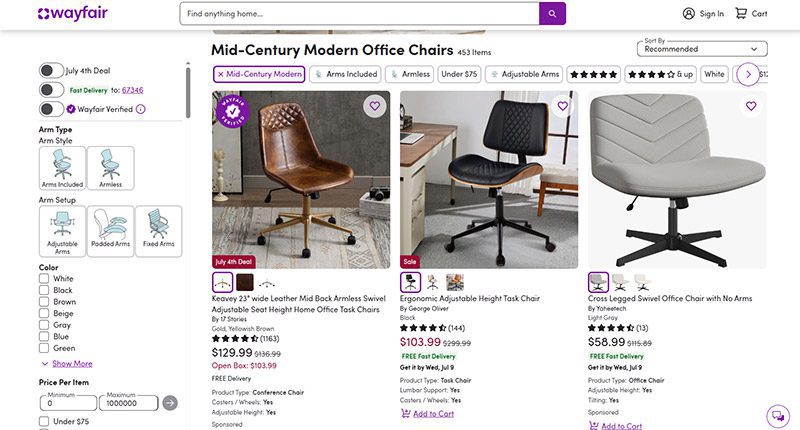
When it comes to furniture, Wayfair offers the best of both worlds. Their goods, including their mid century modern office chairs, are stylish and affordable. You can get a sturdy task chair for less than $100 or a more distinguished seat for less than $350.
MCM office chair examples: Dovray ($126), Bradford ($139), Lithonia ($133)
2) France & Son
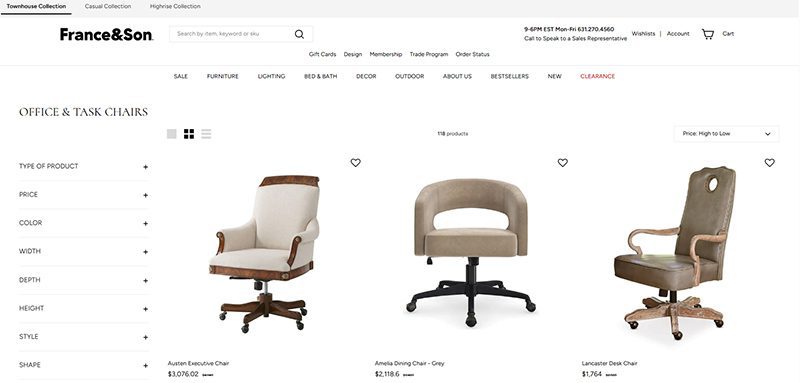
Wayfair’s chairs are affordable, but France & Son is the perfect option for luxury shoppers. Their mid century modern office chairs are robust and sleekly designed. If you dress to impress and enjoy the finer things in life, these are the chairs for you.
MCM office chair example: Brooks ($695)
3) Houzz
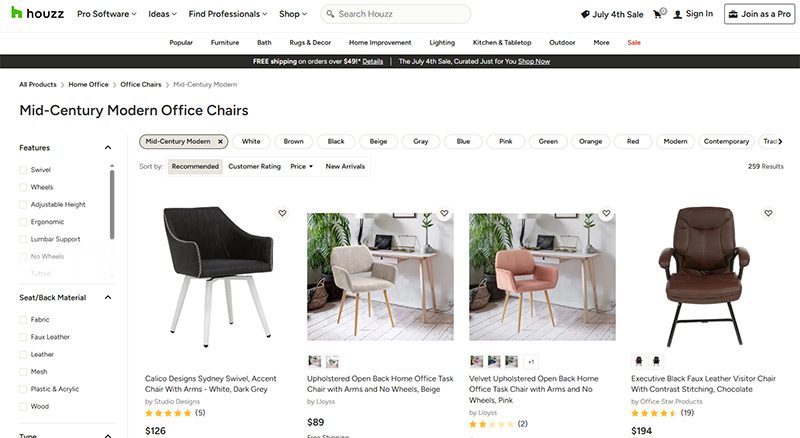
Started as a community for people to share home decor tips, Houzz has become a great ecommerce platform for finding stylish furniture. They’re more known for home decor than desk chairs, but they have plenty of great, affordable finds if you know where to look.
MCM office chair examples: Arvilla ($173), Rathburn ($259)
4) Laura Davidson
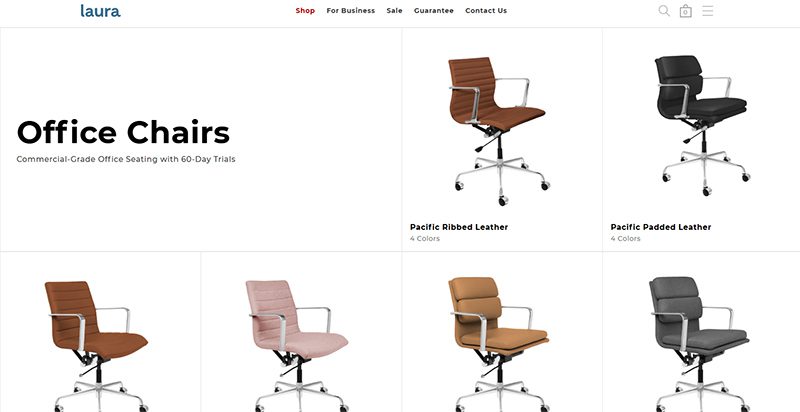
The Laura Davidson collection offers a fairly limited selection of classic office furniture. Still, there’s a reason they’re trusted by big-wigs like Apple, Disney, and Salesforce. Their chairs are sturdy and beautifully designed, reimagining classic Eames and Knoll designs.
MCM office chair examples: Rockefeller ($275), SOHO II Soft Pad ($450)
5) Icons of Manhattan
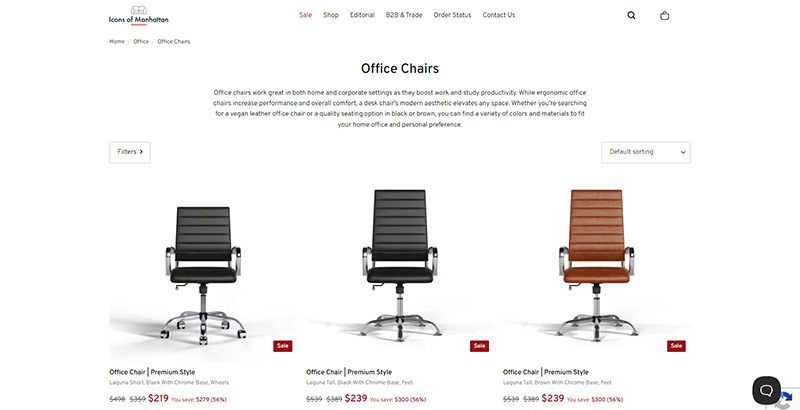
Icons of Manhattan has a simple philosophy: do one thing, and do it right. Their office chairs are handcrafted from premium materials and tailored to a mid-century modern style. If you want that Mad Men energy in your office (hopefully with a lot less angst), these are the chairs for you.
MCM office chair example: Ribbed Medium ($219)
6) Amazon
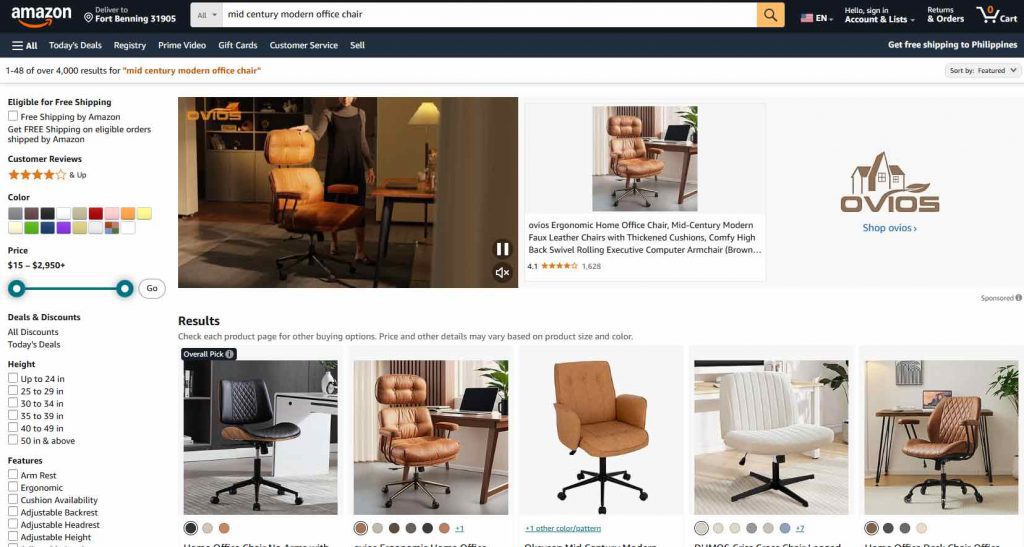
Yes, the internet’s premier shopping destination has a robust collection of mid century modern office chairs. Like with most products, their selection of seats is vast and can be hit or miss. Still, they’ve got stunning chairs available for any style, whether you care about comfort, class, or ergonomics.
MCM office chair examples: IDS Home Modern ($219), Art Leon MCM Swivel ($139)
7) AllModern
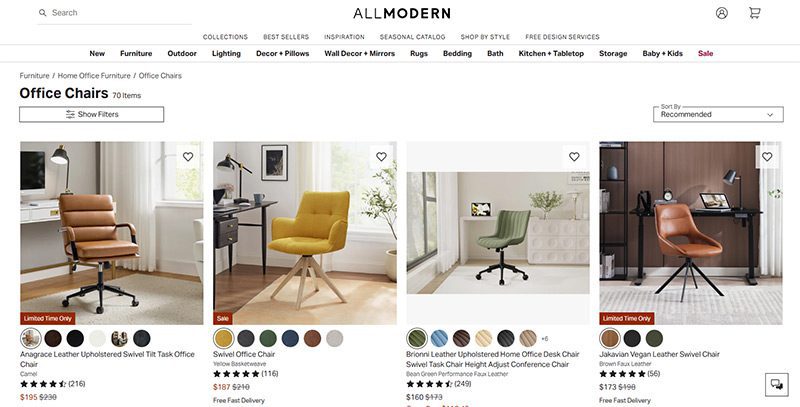
AllModern’s collection of desk chairs and other furniture truly embodies the mid century modern spirit. Their work is tight, angular, and functional above all. They’re part of the Wayfair family and they traffic in a number of modern styles, but their sleek chairs are perfect for any mid century modern space.
MCM office chair examples: Frederick ($229), Kealey ($349)
8) Overstock
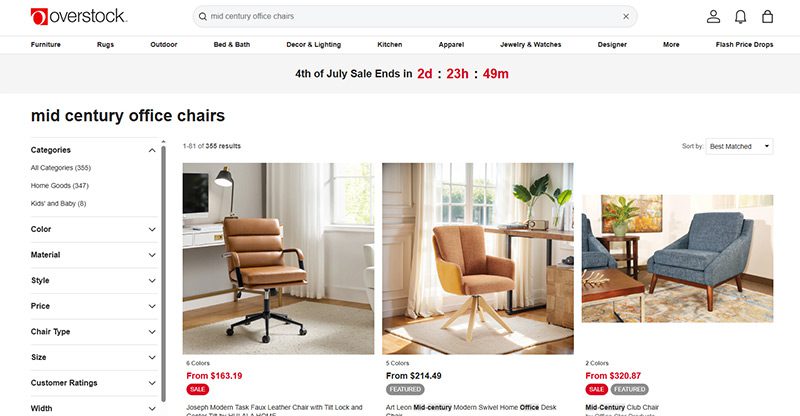
Overstock is known as a one-stop shop for quality home goods at sub-wholesale prices. If you want a spiffy mid century modern office chair that won’t break the bank, they’re the first place to look. While they’re somewhat less reliable than the more upscale platforms on this list, their selection is massive.
MCM office chair example: Joseph Modern ($163)
9) Walmart
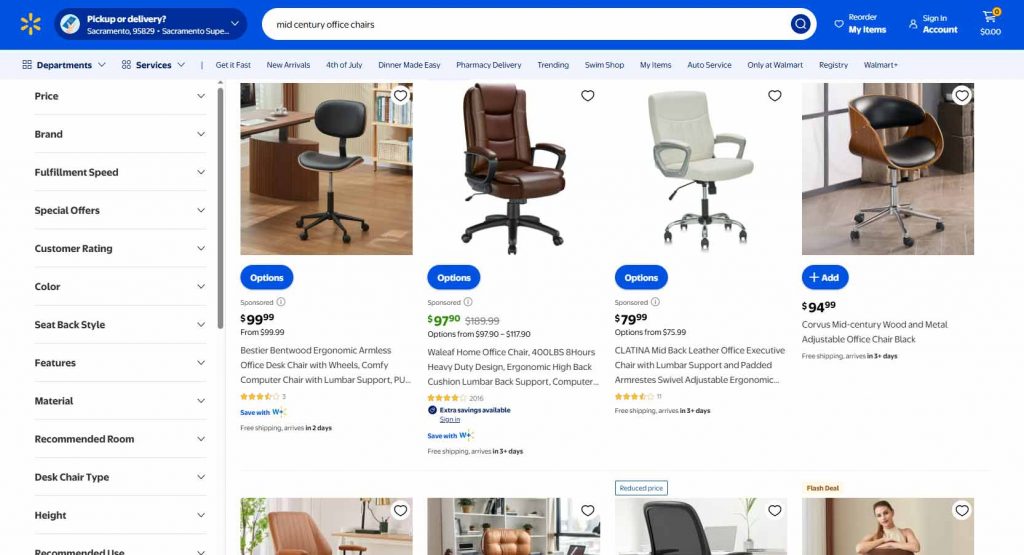
Hayneedle’s selection of mid-century modern office chairs falls somewhere between the minimal Laura Davidson and the endless Amazon catalog. Their array of mid-century designs is affordable and versatile, with chairs that match almost any style. While they may be part of the Walmart family, these chairs are anything but second-rate.
MCM office chair example: Waleaf ($97)
10) Target

Why splurge when you can save? As usual, Target is a hidden gem, offering a sturdy selection of mid century modern office chairs for some of the cheapest prices out there. Many of the chairs they offer are from the same designers as these other stores—Christopher Knight, LumiSource, Armen Living, etc.—at reduced prices.
MCM office chair example: Lombardi ($136)

A quality payroll service is one of the most invaluable tools any entrepreneur can have. Whether you’re a small business owner or an HR manager, paying your employees on time is crucial. This makes choosing a service even more weighty, after all, it is a heavy administrative burden. The good thing is, you can outsource this duty to an online payroll processor.
According to statistics, 49% of workers begin a new job search after just two paycheck errors, and with 65% of workers living paycheck to paycheck, it’s more important than ever to ensure an efficient, effective payroll process.
These services can save you precious time and mitigate potential issues. To make it easy for you to choose, we listed the best online payroll services for 2025.
Top 5 Online Payroll Services
Gusto
Gusto is a great option for both new and experienced payroll administrators, boasting an incredibly clean user interface and a first-rate payroll setup. Gusto lets you manage your employee’s time off (vacation and sick pay), company health insurance, and worker’s comp. Gusto offers excellent mobile access, too. This allows employees to manage aspects of their Gusto profiles, view payday insights, and access Gusto Wallet financial tools.
Gusto offers four tiers of membership, the most affordable of which is the Contractor’s Only plan, which offers unlimited U.S.-based and global contractor payments, supporting more than 100 countries, plus 1099 creation and filing at a rate of $6 per person per month with no base price.
The other three are Simple, Plus, and Premium. Here’s a deeper look into each plan:
Simple
Price:
$40/mo + $6/mo per person
Plan details:
- Full-service single-state payroll including W-2s and 1099s
- Employee profiles and self-service
- Basic hiring and onboarding tools
- Gusto-brokered health insurance administration
- Employee financial benefits
- Payroll and time-off reports
- Custom admin permissions
- Integrations for accounting, time tracking, expense management, and more
Plus
Price:
$80/mo + $12/mo per person
Plan details:
(All Simple plan features +)
- Full-service multi-state payroll including W-2s and 1099s
- Next-day direct deposit
- Advanced hiring and onboarding tools
- PTO management and policies
- Time tracking and project tracking
- Workforce costing and custom reports
- Team management tools
- Full support
Premium
Price:
Bespoke pricing, reach out for a personalized quote
Plan details:
(All Plus plan features +)
- HR Resource Center
- Compliance alerts
- Access to certified HR experts
- Full-service payroll migration and account setup
- Health insurance broker integration
- R&D tax credit discount
- Waived fees and exclusive pricing
- Performance reviews
- Employee surveys and insights
- Dedicated support
QuickBooks Online Payroll
Founded in 1983, Intuit is a California-based financial software company. Since its inception, Intuit has developed into one of the best-known providers of accounting software. Their online payroll service, QuickBooks, includes the essential features you need to run payroll.
QuickBooks offers three tiers of membership. The least expensive membership covers basic accounting features, such as invoices. For more features, check out the Essentials and Plus memberships. Each plan’s features are as follows:
QuickBooks Simple Start (2025)
- Price: $38/month for 1 user
- Best for: Freelancers and small teams with basic payroll needs
Features:
- Automated bookkeeping
- 5 free ACH bank transfers/mo for bills
QuickBooks Essentials (2025)
- Price: $75/month for 3 users
- Best for: Small businesses needing deeper financial tracking
Features:
- Includes all Simple Start features, plus:
- Recurring invoices
QuickBooks Plus (2025)
- Price: $115/month for 5 users
- Best for: Growing businesses with HR and compliance needs
Features:
- Includes all Essentials features, plus:
- AI-powered profit & loss insights
- Anomaly detection and resolution
- Budgeting
QuickBooks Advanced (2025)
- Price: $275/month for 25 users
- Best for: Established businesses with HR and compliance needs
Features:
- Includes all Plus features, plus:
- Custom user management and permissions
- Custom report builder
- Data sync with Excel
- Revenue recognition
- Forecasting
OnPay
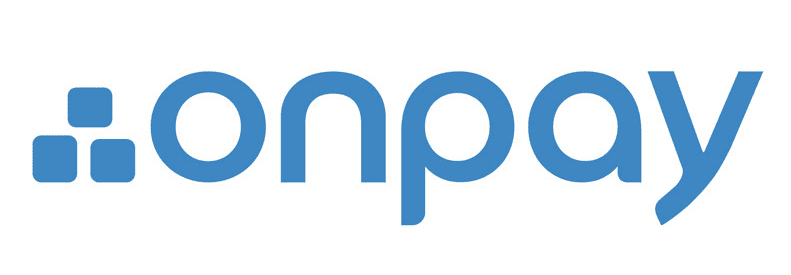
OnPay is a cloud-based full-service payroll processing system capable of running payroll according to a preset schedule, automatically disbursing wages, and calculating and withholding taxes.
OnPay can sync up with several other software your team is already using, making it easy to integrate the service into your team’s system. Another benefit of OnPays model is the simple, transparent pricing structure. No tiers; just one base rate.
Pricing:
$49/mo + $6/mo per employee
SurePayroll

SurePayroll’s award-winning service supports W-2 employees and 1099 contractors. Additionally, it handles 401(k) deductions and manages flexible spending accounts (FSA) and health savings accounts (HSA).
SurePayroll also offers a mobile app— available on both Apple and Android devices.
SurePayroll offers live support through its United States-based support team through chat, email, or phone.
Small Business Payroll
- Price: No Tax Filing: $20/month + $4 per employee, Full Service: $29/month + $7 per employee
- Best for: Small businesses and startups
Features:
- We file and deposit your federal and state taxes!
- Run payroll in 3 simple steps
- Schedule payroll to run automatically
- Unlimited payroll runs and free 2-day direct deposit
- Reports and pay stubs are available online 24/7
- Supports W-2 employees and 1099 contractors
Nanny & Household Payroll
- Price: Full-Service Household, $39/month, includes 1 employee, $10 per additional employee
Best for: Homeowners
Features:
- Signature-ready Schedule H
- We file & deposit your federal and state taxes!
- Run payroll in 3 simple steps
- Schedule payroll to run automatically
- Unlimited payroll runs and free 2-day direct deposit
- Reports & paystubs available online 24/7
- Supports W-2 employees & 1099 contractors
Be sure to choose a payroll service that works for your business, and provides you with the peace of mind that comes with a reliable bookkeeping system. Your employees will thank you.

Merck is currently in talks to acquire Seagen, a biotech company. The Wall Street Journal reports that the transaction is valued at $40 billion. And what happens if Merck acquires Seagen, and how would this acquisition benefit cancer research and treatment? Read more about the Merck Seagen buyout here.
Merck Seagen Buyout
Merck and Seagen are still deciding on their share prices. So far, talks have yet to reach an agreement on $200 per share. Both companies want to settle and finalize their deals before Merck announces its quarterly earnings on July 28. At the time of writing, Seagen’s stock was at $176.19.
With an estimated market value of $235 billion, Merck is looking to expand its presence in the cancer treatment space. The Merck Seagen Buyout could play a major role in that strategy. Since Seagen specializes in targeted cancer therapies, the acquisition would give Merck access to a broader range of oncology products.
Shareholder reactions to the new deal are overwhelmingly positive, and the stocks have been up since talks about the deal have been made public.
But this is not the first time that Merck and Seagen have made the news. Back in 2020, they collaborated because of cancer treatments. Seagen has a drug conjugate (ladiratuzumab vedotin) which would be used in conjunction with Merck’s Keytruda.
Merck reveals that Keytruda is its highest-selling product. It’s immunotherapy for cancer.
And this deal could help Merck offset the possibility of reduced sales because it will lose patent protection in 2028.
As promising as this deal is, there could be scrutiny from antitrust officials since there might be a litigation case from the Federal Trade Commission or Justice Department.
The Seagen buyout isn’t the only deal Merck has made recently. They’ve been busy closing another deal, but with Orion too.
Seagen
As a cancer biotech company, Seagen has therapies to ensure that patients benefit from the treatment and reduce any adverse side effects. Their treatments involve the therapy attacking tumors with toxins.
Merck partnering with Seagen isn’t a bad idea considering that Seagen made $1.4 billion in sales in 2021, most of it coming from Adcetris and Padcev (a treatment for urothelial cancers).
Merck-Orion Deal
In the middle of the Merck Seagen Buyout, Merck has recently partnered with Orion for the ODM-208 and other drugs. These drugs are related to the production of steroids. Orion found how it can combat hormone-dependent cancers and further developed this inhibitor.
Their deal includes that they should develop ODM-208 and promote it to the public together. And Orion will receive a $290 million payment from Merck.
Although they’re co-developing and marketing the new inhibitor, Orion will oversee the manufacturing side.
Co-developing the ODM-208 can help Merck with its current research and treatments for prostate cancer. President and CEO of Orion, Timo Lappalainen, says that this partnership will benefit Merck’s goals of treating cancer worldwide.
Other Ventures: Merck’s Role in the Pandemic
You may have heard about COVID-19 pills, which are a form of treatment for those diagnosed with mild to moderate COVID-19. Merck introduced an antiviral COVID-19 pill to the public. The name: Molnupiravir.
The COVID-19 pill is not a replacement for a vaccination. Instead, it stops the replication of the COVID-19 genetic code and keeps the patient out of the hospital. Not yet FDA-approved, Molnupiravir has been authorized for emergency use since December 23, 2021.
And for other stories, read more here at Owner’s Mag!

What Is Tiktok Pink Sauce? The Viral Condiment, Explained

Did You Drop Your Smartphone in The Ocean? Here’s How to Retrieve It

Gift Guide: 25 Best Gifts for Women for All Occasions

History of the NBA: The Success Behind the Big League

Demio SaaS 2025 Review: Features, Pricing, Pros & Cons

Top 12 Uses for The Metaverse That Will Change Your Life

Top 10 Best Places to Buy a Mid Century Modern Office Chair

Top 10 Best Places to Buy a Mid Century Modern Office Chair

History of the NBA: The Success Behind the Big League

8 Best Equipment for YouTube Every Content Creator Needs

Demio SaaS 2025 Review: Features, Pricing, Pros & Cons

Did You Drop Your Smartphone in The Ocean? Here’s How to Retrieve It

Top 10 Small Business Organization Tools for 2025

Top 12 Uses for The Metaverse That Will Change Your Life
Trending
- Entertainment5 days ago
History of the NBA: The Success Behind the Big League
- Lifestyle4 days ago
Did You Drop Your Smartphone in The Ocean? Here’s How to Retrieve It
- Lifestyle5 days ago
Gift Guide: 25 Best Gifts for Women for All Occasions
- Top Stories4 days ago
What Is Tiktok Pink Sauce? The Viral Condiment, Explained






